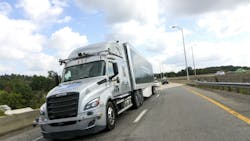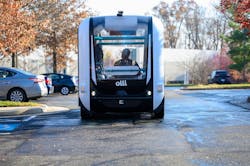Daimler Trucks and Torc Robotics expand autonomous truck testing to new public routes in the U.S.
In this week’s roundup from the Association for Unmanned Vehicle Systems International, which highlights some of the latest news and headlines in unmanned vehicles and robotics, automated truck testing in the United States expands to new public routes, drone archeology, and fully-autonomous shuttles drop their onboard human attendants.
Compiled by Brian Sprowl, Associate Editor, AUVSI
Daimler Trucks, Torc Robotics expanding testing of automated truck technology to new public routes in the U.S.
After completing initial mapping of additional routes, Daimler Trucks and Torc Robotics have announced plans to expand their testing of automated truck technology to new public routes in the U.S.
Partners in Daimler Trucks’ Autonomous Technology Group, Daimler Trucks and Torc began initial public road testing in southwest Virginia last year, where Torc is headquartered. The teams use these public road tests to collect data from real-world traffic scenarios, which is beyond what can be learned from computer simulations and closed road courses.
Daimler Trucks and Torc say that they have been able to “rigorously test, develop and deploy” the automated system thanks to the combination of supportive state and local governments with the well-developed infrastructure and highway systems.
With plans to continue testing the next generation of automated driving software in Virginia, the Autonomous Technology Group will add the upcoming new routes to the data collecting.
“Safety is our highest priority. By expanding our testing to new routes in the U.S. we are able to learn more, work with various partners and apply our advanced testing methods to new environments,” explains Dr. Peter Vaughan Schmidt, head of Autonomous Technology Group at Daimler Trucks.
“These learnings help us to achieve our goal of safe and reliable highly automated driving, delivering value to our customers and society.”
Daimler Trucks has been testing and validating the durability, reliability and safety of commercial vehicles across the globe for dozens of years. The company has already brought partially automated driving features into series production with the introduction of technologies such as Active Drive Assist (Mercedes-Benz Actros, FUSO Super Great) and Detroit Assurance 5.0 with Active Lane Assist (Freightliner Cascadia).
Meanwhile, Torc’s “Asimov” autonomous driving system has been tested on public roads with zero accidents, including a cross-country journey.
By combining their extensive testing experience, Daimler Trucks and Torc say that they have developed a “comprehensive validation approach and safety protocols for automated driving and are completely aligned with the federal framework policy for testing and commercial deployment of SAE Level 4 automated trucks.”
Drone discovers ancient remains of people from lost pre-Hispanic civilization
A drone discovered a tomb containing the ancient remains of people from a lost pre-Hispanic civilization.
The mummified remains of 72 skeletons—62 adult skeletons and 10 newborns—were found in the Guayadeque ravine on the island of Gran Canaria, which is part of the Spanish Canary Islands.
The discovery has been confirmed by experts, who have linked it to the Guanche civilization, being that the cave dates back to between 800-1000AD.
Guanche people are thought to be the original inhabitants of the Canary Islands. They may have traveled there from North Africa.
“There are many burial caves in Gran Canaria, but not many like this one,” says Archaeologist Veronica Alberto, via the New York Post.
“The discovery of the newborn remains is important as they were not included in previous findings until very recently. We know now they can be found in these types of cave burials.”
After going down to the burial site, archaeologists found traditional burial shrouds made from vegetable fibers and animal skin.
“We can confirm that all the pre-Hispanic people in the Canary Islands were prepared the same way for the burial ceremony,” Alberto says.
To reach the tomb, experts had to travel down 75 feet. The cave was found via drone by members of ‘El Legado,’ an amateur archaeology group formed by Ayose Himar Gonzalez, Jonay Garcia and Jesus Diaz.
“We were flying a drone and we took some pictures of the cave. It is in a very difficult place to access and you need to climb a cliff to reach the site. People thought the photos were fake because of all the bones there!” Gonzalez explains.
The group found the cave back in June 2019, but they only reported it recently due to their concern that it would be vandalized.
“The cave should be closed off and preserved with the bones left there to respect the site. We decided to report it because we want the local authorities to preserve and respect it,” Gonzalez says.
Robotic Research to begin testing fully autonomous shuttles without onboard attendants
Starting in the second quarter of 2020, Robotic Research LLC will begin testing fully autonomous low-speed shuttles that are totally unmanned.
Instead of having the attendants onboard, they will be in fixed on-site locations, with the eventual goal of moving them to an offsite safety monitoring facility.
“Through our work with the U.S. government over the past four years, we have already demonstrated that fully autonomous trucks are a reality. We are committed to making our shuttle and bus manufacturing partners successful by accelerating state-of-the-art technologies for unmanned vehicles ahead of regulatory agencies’ progress,” says Alberto Lacaze, president of Robotic Research.
“The advancements driven by the Robotic Research team will provide a product that significantly reduces the cost of operation and therefore improves market size.”
For nearly 10 years, Robotic Research has been developing and testing unmanned, autonomous operations for a variety of vehicles. Currently, the company provides autonomy kits that fully automate logistics convoy trucks for the U.S. government, as well as several of its allied nation partners, with nearly 100 trucks having already been delivered. Testing for these vehicles have included operations with no safety attendants on board, with a single operator monitoring three unmanned vehicles.
Vehicles of all sizes can be equipped with Robotic Research’s AutoDrive autonomy kit, which is platform agnostic. The system provides autonomous functionality on a wide range of surfaces, all while the vehicle is collecting and analyzing data to “better enhance the future of autonomous vehicles and transportation,” according to Robotic Research.
Local Motors’ Olli autonomous shuttles utilize Robotic Research’s technology. The largest bus manufacturer in North America, New Flyer of America Inc., also utilizes Robotic Research’s technology.
Currently operating in communities and cities across the globe, including 30 states and four continents, Robotic Research's AutoDrive kit supports a number of different autonomy programs in commercial and government sectors.
Share your vision-related news by contacting Dennis Scimeca, Associate Editor, Vision Systems Design

